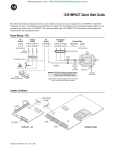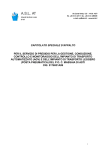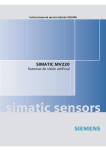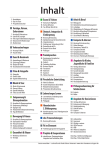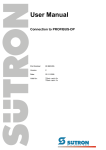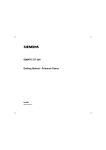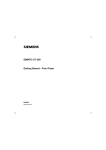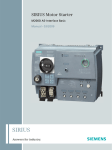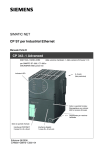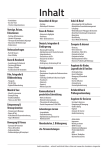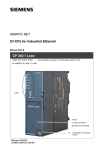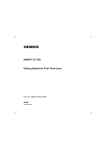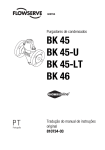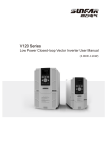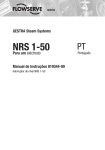Download 22957673_Richtung_Geschwindigkeit_V20_e
Transcript
Application on Control Technology SIMATIC S7 CPU 300/400 Application Description Direction and Speed Detection of metallic Test Objects in the S7-CPU Using inductive BEROs Warranty, liability and support Application inductive BEROs Note Entry ID: 22957673 The application examples are not binding and do not claim to be complete regarding the circuits shown, equipping and any eventuality. The application examples do not represent customer-specific solutions. They are only intended to pro-vide support for typical applications. You are responsible in ensuring that the de-scribed products are correctly used. These application examples do not relieve you of the responsibility in safely and professionally using, installing, operating and servicing equipment. When using these application examples, you recognize that Siemens cannot be made liable for any damage/claims beyond the liability clause described. We reserve the right to make changes to these application examples at any time without prior notice. If there are any deviations between the recommendations provided in these application examples and other Siemens publications - e.g. Catalogs - then the contents of the other documents have priority. Warranty, liability and support Copyright © Siemens AG 2006 All rights reserved 22957673_Richtung_Geschwindigkeit_V20_e.doc We do not accept any liability for the information contained in this document. Any claims against us - based on whatever legal reason - resulting from the use of the examples, information, programs, engineering and performance data etc., described in this application example shall be excluded. Such an exclusion shall not apply in the case of mandatory liability, e.g. under the German Product Liability Act (“Produkthaftungsgesetz”), in case of intent, gross negligence, or injury of life, body or health, guarantee for the quality of a product, fraudulent concealment of a deficiency or breach of a condition which goes to the root of the contract (“wesentliche Vertragspflichten”). However, claims arising from a breach of a condition which goes to the root of the contract shall be limited to the foreseeable damage which is intrinsic to the contract, unless caused by intent or gross negligence or based on mandatory liability for injury of life, body or health The above provisions does not imply a change in the burden of proof to your detriment. Copyright© 2006 Siemens A&D. It is not permissible to transfer or copy these application examples or excerpts of them without first having prior authorization from Siemens A&D in writing. For questions about this document please use the following e-mail address: mailto:[email protected] V 1.0 01/27/06 2/55 Foreword Application inductive BEROs Entry ID: 22957673 Foreword Objective of the application This application was created to provide the user with the following: • • A modifiable and expandable example of a detection of moving metallic objects and the illustration of a convenient option of operating and visualizing a control using a touch panel. This application shows how speed and conveying direction (forward / reverse) of metallic objects or non-metallic objects with metal targets (transport containers) are determined using a SIMATIC controller and three inductive BEROs 1. Copyright © Siemens AG 2006 All rights reserved 22957673_Richtung_Geschwindigkeit_V20_e.doc • This topic is particularly relevant in conveying and handling systems. Main contents of this application This application deals with the following key elements: • • • Design, principle of operation and application of inductive proximity switches (BEROs) STEP7 program of a speed and direction detection of material to be conveyed or objects in a production process Connection of a touch panel for operator control of the process and plant monitoring using WinCC flexible Delimitation This application does not include a description of • • the SIMATIC STEP 7 engineering tool the WinCC flexible visualization software Basic knowledge of these topics is required. 1 BERO = Sensor for the Contactless Recording of Objects V 1.0 01/27/06 3/55 Foreword Application inductive BEROs Entry ID: 22957673 Structure of the document The documentation of this application is divided into the following main parts. Copyright © Siemens AG 2006 All rights reserved 22957673_Richtung_Geschwindigkeit_V20_e.doc Part Description Application Description You are provided with a general overview of the contents. You are informed on the used components (standard hardware and software components and the specially created user software). Principles of Operation and Program Structures This part describes the detailed functional sequences of the involved hardware and software components, the solution structures and – where useful – the specific implementation of this application. It is only required to read this part if you want to familiarize with the interaction of the solution components to use these components e.g. as a basis for own developments. Structure, Configuration and Operation of the Application This part takes you step by step through structure, important configuration steps, startup and operation of the application. Appendix This part of the documentation includes further information, e.g. bibliographic references, glossaries, etc. Reference to Automation and Drives Service & Support This entry is from the internet application portal of Automation and Drives Service & Support. The documentation has the entry ID 22957673. Click the link below to directly display the download page of this document. http://support.automation.siemens.com/WW/view/en/22957673 All entries referenced in this document are designated by their entry ID and addressed via the above path. V 1.0 01/27/06 4/55 Foreword Application inductive BEROs Entry ID: 22957673 Table of Contents Application Description ............................................................................................... 6 1 1.1 1.2 Automation Problem ...................................................................................... 6 Overview........................................................................................................... 6 Requirements ................................................................................................... 8 2 2.1 2.2 2.2.1 2.2.2 2.3 2.4 Automation Solution .................................................................................... 10 Overview of the overall solution...................................................................... 10 Description of the core functionality................................................................ 11 Overview and description of the user interface............................................... 11 Sequence of the main functionality................................................................. 15 Required hardware and software components ............................................... 17 Performance data ........................................................................................... 20 Copyright © Siemens AG 2006 All rights reserved 22957673_Richtung_Geschwindigkeit_V20_e.doc Principles of Operation and Program Structures .................................................... 22 3 3.1 General Function Mechanisms.................................................................... 22 Basics on “inductive sensors” ......................................................................... 22 4 4.1 4.2 4.2.1 4.2.2 4.2.3 4.2.4 Explanations on the Example Program ...................................................... 24 The structure of the STEP7 program .............................................................. 24 Detailed description of the individual software blocks .................................... 25 FB 1 (Direction and Speed Detection of Moving Objects) .............................. 26 FC 1 (Direction) .............................................................................................. 30 FC 2 (Speed) .................................................................................................. 31 DB 11 (DISPLAY&PARAM) ............................................................................ 32 5 5.1 5.1.1 5.1.2 5.2 5.3 5.3.1 5.3.2 5.4 Modifications to the Example Program (optional) ..................................... 33 Different BERO distances............................................................................... 33 Loading from sample project .......................................................................... 33 Modifying blocks yourself................................................................................ 34 Changing the flicker frequency ....................................................................... 36 Direction and speed detection with two BEROs ............................................. 38 Loading from sample project .......................................................................... 39 Modifying blocks yourself................................................................................ 40 Changing the runtime language (TP170A) ..................................................... 45 Structure, Configuration and Operation of the Application ................................... 46 6 6.1 6.2 6.3 Installation and Startup................................................................................ 46 Installation of hardware and software ............................................................. 46 Installation of the application software ............................................................ 47 Startup ............................................................................................................ 51 Appendix and Literature ............................................................................................ 54 7 V 1.0 Literature ....................................................................................................... 54 01/27/06 5/55 Application Description Automation Problem Application inductive BEROs Entry ID: 22957673 Application Description Content You are provided with a general overview of the contents. You are informed on the used components (standard hardware and software components and the specially created user software). The displayed performance data illustrate the performance capability of this application. 1 Automation Problem You are provided with information on… Copyright © Siemens AG 2006 All rights reserved 22957673_Richtung_Geschwindigkeit_V20_e.doc the specific automation problem described in this documentation. 1.1 Overview Introduction For the purpose of... • • • time coordination of sequential production steps of a production process optimization of the conveying flow in a conveyor system (e.g. freight center) direction control of the material to be conveyed it is required that speed and/or direction of motion of the material to be conveyed are detected with contactless sensors. Using a PLC, this information is used to control the conveying flow. An HMI (human machine interface, e.g. a touch panel) enables to monitor the conveying flow and direction decisions by operator inputs are possible. Overview of the automation problem The below figure shows an example of a possible field of application for this application. V 1.0 01/27/06 6/55 Application Description Automation Problem Application inductive BEROs Entry ID: 22957673 Copyright © Siemens AG 2006 All rights reserved 22957673_Richtung_Geschwindigkeit_V20_e.doc Figure 1-1: Field of application of sensors for process monitoring Description of the automation problem In a technical plant, a conveyor section is to be monitored, which can run in both directions at different speeds. This is done to avoid disturbances of the coordination in the interaction of different production steps. This requires contactless detection of the containers transported on the conveyor elements by sensors. Using the sensor signals, both the direction of motion and the speed of the objects are to be determined and displayed on an output device. Figure 1-1 merely illustrates the rough topic of the application. The detail problem of the speed and direction detection is illustrated in Figure 1-2. Not reflex sensors as shown in the above figure but inductive BEROs are used as sensors. Their robustness and insensitivity to dirt ensure reliable operation also under harsh conditions and they are thus widely used in the industrial field. However, this requires that the objects to be detected consist of metal (at least partly) or that they have a metal target (special transport containers) for the BERO detection. To avoid misinterpretations during the object detection, not only two but three sensors are to detect the passing objects. Direction and speed are only determined after all three sensors have successively signaled the object. V 1.0 01/27/06 7/55 Application Description Automation Problem Application inductive BEROs Entry ID: 22957673 Figure 1-2: Schematic view of the automation problem BERO 1 BERO 2 BERO 3 s2 = s reverse forward material to be conveyed s1 = s conveyor section s2 = s tv tR Copyright © Siemens AG 2006 All rights reserved 22957673_Richtung_Geschwindigkeit_V20_e.doc m = 2s tBERO 1 1.2 tBERO 2 tBERO 3 s1 = s2 = s tV distance between BEROs measured time with discharge direction "forward" tR m measured time with discharge direction "reverse" complete measuring distance Requirements This application is realized in a STEP7 project. It is to meet the requirements listed below: Sensor requirements • • Metallic objects (material to be conveyed) which are to be conveyed past the sensors are to be detected by them. If an object comes into the detection range of a sensor, this causes a signal change from 0 to 1 at the switching output of the sensor. The sensors are to be designed as inductive proximity switches (BEROs). Controller requirements • • • V 1.0 Using the sensor signals, direction and speed of the material to be conveyed are to be determined if the conveyor section is switched on. Each object detection is to be provided with a time stamp. Depending on the last determined current direction, a corresponding digital output is to be controlled (flashing). 01/27/06 8/55 Application Description Automation Problem Application inductive BEROs • Entry ID: 22957673 If no further object passes all three sensors within a variable time after an object detection, the displays on the HMI (direction display, speed) and the respective digital output (flashing direction display) of the controller are to be reset. HMI requirements • Copyright © Siemens AG 2006 All rights reserved 22957673_Richtung_Geschwindigkeit_V20_e.doc • • Note V 1.0 The HMI is to be realized by a touch panel (screen diagonal 6 inches). The following information is to be displayed: – The direction of the material to be conveyed (forward/reverse) – The speed of the material to be conveyed (in m/s) – The time stamp of the last object detection – Mode of the conveyor section (ON/OFF) – Status of the direction detection (enabled/disabled) – Status of the speed detection (enabled/disabled) The following operations are to be possible: – Enabling/disabling the direction detection – Enabling/disabling the speed detection – Terminating the runtime – Entering the sensor distance – Entering the display duration The above-mentioned requirements are met by the application software without need for additional programming overhead or entering parameters in data blocks. 01/27/06 9/55 Application Description Automation Solution Application inductive BEROs 2 Entry ID: 22957673 Automation Solution You are provided with information on… the solution selected for the automation problem. 2.1 Overview of the overall solution Diagrammatic representation The following figure schematically shows the most important components of the solution: Copyright © Siemens AG 2006 All rights reserved 22957673_Richtung_Geschwindigkeit_V20_e.doc Figure 2-1: Hardware overview of the automation solution Structure A SIMATIC CPU 314C-2 DP is the key element of the application. This central processing unit already includes the digital inputs and outputs required by the application. The switching outputs of the three inductive BEROs are directly connected to the three digital inputs integrated in the V 1.0 01/27/06 10/55 Application Description Automation Solution Application inductive BEROs Entry ID: 22957673 central processing unit. The TP170A touch panel is connected to the MPI of the controller via a PROFIBUS cable. The controller and the BEROs as well as the touch panel are supplied with 24V DC by the PS 307 power supply. 2.2 Description of the core functionality 2.2.1 Overview and description of the user interface A TP 170A touch panel is primarily used as HMI. The display/HMI is realized by three screens: • Start screen (main screen) • Releases screen • Parameters screen Copyright © Siemens AG 2006 All rights reserved 22957673_Richtung_Geschwindigkeit_V20_e.doc In addition, the passing of the BEROs is displayed by optional flickering of two digital output bits (forward, reverse). TP 170A – Start screen Figure 2-2: Start screen Provided that the touch panel has already been loaded with the HMI software created in WinCC flexible, the above start screen – which at the same time is to be considered as main screen – is displayed when applying the supply voltage. The following data are displayed: V 1.0 01/27/06 11/55 Application Description Automation Solution Application inductive BEROs Entry ID: 22957673 1. Direction A direction detection is only performed if it is enabled (see “Releases screen”) and if the conveyor section is in operation. As soon as an object has been detected by all three sensors, its conveying direction is indicated by an “X” in the corresponding box. After a defined display duration has elapsed (see “Parameters screen”), the “X” disappears. For the definition of the terms “forward” and “reverse” see Figure 1-2. If the connection to the PLC fails, the display is no longer updated and keeps the last status (“ “ or “X”). Copyright © Siemens AG 2006 All rights reserved 22957673_Richtung_Geschwindigkeit_V20_e.doc 2. Last Registration If the conveyor section runs and if the direction detection is enabled (see “Releases screen”), the last object passing the three BEROs is provided with a direction-dependent time stamp. The time is from the PLC clock. Another object with the same conveying direction overwrites the time stamp. “###...“ is displayed if there is no connection to the PLC. The time stamps of both conveying directions are updated during the STOPÆRUN transition of the PLC. 3. conveyor section: The mode is displayed (ON = conveyor is running / OFF = conveyor is not running). If the connection to the PLC fails, the display is no longer updated and keeps the last status (“ON“ or “OFF”) 4. actual speed [m/s]: A speed detection is only performed if the conveyor section is in operation. As soon as an object has passed all three sensors, the determined speed is displayed. After a defined display duration has elapsed (see “Parameters screen”), the speed display is reset to “0.000”. If there is no connection to the PLC, “#####” is displayed. 5. Direction Detection It is displayed whether the direction detection is “disabled” or “enabled” (see “Releases screen”). The direction is only displayed according to point 1 if the direction detection is enabled. If the connection to the PLC fails, the display is no longer updated and keeps the last status (“disabled” or “enabled”). 6. Speed Detection It is displayed whether the speed detection is “disabled” or “enabled” (see “Releases screen”). The speed is only displayed according to point 4 if the speed detection is enabled. If the connection to the PLC fails, the display is no longer updated and keeps the last status (“disabled” or “enabled”). Three buttons to call additional screens are located at the bottom of the display: V 1.0 01/27/06 12/55 Application Description Automation Solution Application inductive BEROs Entry ID: 22957673 1. releases Use this button to branch to the “Releases screen” for the enable/disable of the direction and speed display. 2. parameters Use this button to branch to the “Parameters screen” for defining the sensor distances and the display duration. 3. stop runtime Use this button to terminate the application on the touch panel and to call its start menu. TP 170A – Releases screen Copyright © Siemens AG 2006 All rights reserved 22957673_Richtung_Geschwindigkeit_V20_e.doc Figure 2-3: Releases screen Use the “releases” button in the “start screen” to display the “Releases screen”. 1. Direction Detection Use the “enable/disable” button to activate or deactivate the direction detection. The box to the right of the button displays the selected mode and is identical to the corresponding display in the start screen. 2. Speed Detection Use the “enable/disable” button to activate or deactivate the speed detection. The box to the right of the button displays the selected mode and is identical to the corresponding display in the start screen. V 1.0 01/27/06 13/55 Application Description Automation Solution Application inductive BEROs Entry ID: 22957673 Use the back button located at the bottom of the display to return to the start screen. TP 170A – Parameters screen Copyright © Siemens AG 2006 All rights reserved 22957673_Richtung_Geschwindigkeit_V20_e.doc Figure 2-4: Parameters screen Use the “parameters” button in the “start screen” to display the “Parameters screen”. When selecting (touching) the respective I/O box, a numerical keyboard is displayed on the screen with which you can enter the desired value and apply it using the Enter key. 1. Sensor Distance Enter the distance between the BEROs according to Figure 1-2. The application can operate with values between 0.0 and +99.9. Negative values are converted to positive values when entered. Values >99.9 are limited to +99.9. 2. Display Period You enter the time after which a direction and/or speed display is to be reset on the display. The application can operate with values between 0 and +60. Negative values are converted to positive values when entered. Values >60 are limited to +60. Use the back button located at the bottom of the display to return to the start screen. V 1.0 01/27/06 14/55 Application Description Automation Solution Application inductive BEROs Entry ID: 22957673 LED displays Aside from the visualization on the TP170A, the last detected direction is indicated by optional flickering (fast flashing) by two digital outputs. • Conveying direction forward: A 4.0 • Conveying direction reverse: A 4.1 The duration of the flickering corresponds to the display duration. The digital outputs could e.g. be used to control indicator lights. 2.2.2 Sequence of the main functionality Copyright © Siemens AG 2006 All rights reserved 22957673_Richtung_Geschwindigkeit_V20_e.doc The following flowchart illustrates the core functionality “detection of direction and speed”. It refers to the time and path designations in Figure 1-2. It is assumed that direction and speed detection are enabled. V 1.0 01/27/06 15/55 Application Description Automation Solution Application inductive BEROs Entry ID: 22957673 Figure 2-5: Flowchart of the core functionality start N timer for display period elapsed? Y reset display for direction and speed N positive edge at BERO 2? Y save time stamp tBERO 2 Copyright © Siemens AG 2006 All rights reserved 22957673_Richtung_Geschwindigkeit_V20_e.doc set detection flag of BERO 2 N positive edge at BERO 1? Y detection flag of BERO 2 and BERO 3 already set? Y N Y display "reverse" with time stamp tBERO 1 calculate and display speed v = s/tR detection flag of BERO 2 already set, but not of BERO 3? N start / retrigger display period set detection flag of BERO 1 reset detection flags of BERO 2 and BERO 3 N positive edge at BERO 3? Y detection flag of BERO 2 and BERO 1 already set? Y N Y detection flag of BERO 2 already set, but not of BERO 1? N display "forward" with time stamp tBERO 3 calculate and display speed v = s/tV start / retrigger display period set detection flag of BERO 3 reset detection flags of BERO 2 and BERO 1 events end V 1.0 01/27/06 16/55 Application Description Automation Solution Application inductive BEROs 2.3 Entry ID: 22957673 Required hardware and software components The application was developed and tested with the following components. Please consider that configuration changes in the sample project are possibly required in case of deviations from the listed components and that screen shots in this document can differ from your screen contents. To realize the sample project, you additionally require: • PG or PC with corresponding communications processor (e.g. CP5512) and Microsoft ® Windows 2000 Professional or Windows XP Professional operating system. • An MPI cable. Hardware components Table 2-1: Hardware components Copyright © Siemens AG 2006 All rights reserved 22957673_Richtung_Geschwindigkeit_V20_e.doc Component MLFB / Order number Note SIMATIC S7-300, RAIL L=480MM 1 6ES7390-1AE80-0AA0 = minimum length SIMATIC S7-300, LOAD POWER SUPP. PS 307, AC 120/230V, DC 24V, 2A 1 6ES7307-1BA00-0AA0 Or similar power supply SIMATIC S7-300, CPU 314C-2 DP COMPACT 1 6ES7314-6CF02-0AB0 The compact version was only used because of the integrated DO/DI. SIMATIC S7, MICRO MEMORY CARD F. S7-300/C7/ET 200S IM151 CPU, 3,3 V NFLASH, 64 KBYTE 6ES7953-8LF11-0AA0 Or larger SIMATIC S7-300, FRONT CONNECTOR 392 WITH SCREW CONTACTS, 40-PIN 6ES7392-1AM00-0AA0 Also available with spring contacts 6AV6545-0BA15-2AX0 Configurable with ProTool/Lite from version V5.2, SP1 and WinCC flexible Compact from version 2004 SIMATIC TOUCHPANEL TP170A BLUE MODE STN-DISPLAY MPI/PROFIBUS-DP INTERFACE V 1.0 No. 1 01/27/06 17/55 Application Description Automation Solution Application inductive BEROs Entry ID: 22957673 Copyright © Siemens AG 2006 All rights reserved 22957673_Richtung_Geschwindigkeit_V20_e.doc Component No. MLFB / Order number Note SIMATIC NET, CONN. CABLE 830-2 F. PROFIBUS, PREASSEMBLED CABLE WITH 2 SUB-DCONNECTORS 9-POLE, SWITCHABLE TERMINATING RESISTORS, 3 M 1 6XV1830-2AH30 2-wire shielded cable with PROFIBUS connectors for connecting the TP 170A to the CPU. For alternatives see /6/. PROXIMITY SWITCH BERO CUBIC 40 MM X 40 MM INDUCTIVE, 15...34 V DC, SN=15 MM, FLUSH, NO+NC, 200 MA, PNP, 4-WIRE, MOLD. PLASTIC, SHORTY, SENSOR ADJUSTABLE IN 5 DIR., WITH M12 CONN. ROTATABLE, IP67 3 3RG4038-3CD00 Or equivalent inductive proximity switch M12 ANGLED CABLE PLUG, 4-POL. WITH 5M CABLE PUR BLACK, 4 X 0.34MM2 3 3RX8000-0CE42-1AF0 Or equivalent component Standard software components Table 2-2: Standard software components Component V 1.0 No. MLFB / Order number Note SIMATIC S7, STEP7 V5.3, FLOATING LICENSE FOR 1 USER, E-SW, SW AND DOCU. ON CD, LICENSE KEY ON FD, CLASS A, 5 LANGUAGES (G,E,F,I,S), EXECUTABLE UNDER WIN2000PROF/XPPROF REFERENCE-HW: S7300/400, C7 1 6ES7810-4CC07-0YA5 For sources for Service Pack 3 see /7/. WINCC FLEXIBLE 2005 COMPACT ENGINEERING-SW, FLOATING LICENSE LICENSE KEY ON FD SW AND DOCUMENTATION ON CD IN GER/EN/IT/FR/SP, EXEC. UNDER WIN2000/XPPROF FOR CONFIGURATION OF SIMATIC PANELS UPTO SERIES 170 1 6AV6611-0AA01-1CA5 TP170A requires at least WinCC flexible Compact. 01/27/06 18/55 Application Description Automation Solution Application inductive BEROs Entry ID: 22957673 Example files and projects The following list contains all files and projects used in this example. Table 2-3: Example files and projects Component BIDxyz_Richtg_Geschw_V20_e.zip This zip file contains the STEP 7 project. The visualization with the aid of a touch panel is integrated in the STEP7 project. The “direction and speed detection” functionality is also complied with without visualization. Copyright © Siemens AG 2006 All rights reserved 22957673_Richtung_Geschwindigkeit_V20_e.doc Note Note V 1.0 01/27/06 19/55 Application Description Automation Solution Application inductive BEROs 2.4 Entry ID: 22957673 Performance data Sensors Table 2-4: Data of the proximity switch 3RG4038-3CD00 Feature Data/notes Operating voltage 15...34 V DC No-load supply current Io Max. 30 mA (24 V) Max. 40 mA (34 V) Rated operational current Ie 200 mA ( ≤ 50°C) 150 mA (≤ 85°C) Enclosure material Molded plastic Design Cubic 40 mm x 40 mm 4 lines (connector M12): Copyright © Siemens AG 2006 All rights reserved 22957673_Richtung_Geschwindigkeit_V20_e.doc Connections V 1.0 1 Æ Plus 3 Æ Mass 4 Æ Signal (make contact element) Comment Colors (connection lines): Brown Blue Black Switching type PNP Display LED green ÆPower supply LED yellowÆSwitching status Rated operating distance sn 15 mm +/- 10 % Buttability 75 mm (center to center) Otherwise mutual disturbance possible Switching frequency f 50 Hz Repeat accuracy R 0.75 mm Power-up delay tv 100 ms Degree of protection IP 67 Operating temperature -25°C to 85°C 01/27/06 20/55 Application Description Automation Solution Application inductive BEROs Entry ID: 22957673 Application software Copyright © Siemens AG 2006 All rights reserved 22957673_Richtung_Geschwindigkeit_V20_e.doc Table 2-5: Performance data of the application software V 1.0 Criterion Performance data Program size MMC: 6086 bytes Main memory: 4200 bytes Maximum cycle time 3 ms For CPU according to Table 2-1 Minimum object distance Entire measuring distance “m” (compare Figure 1-2) Only one object permitted in measuring distance Object length Any Object must be securely detected by BERO. Sensor distance “s” (default value in DB11) 25.0 cm User parameter (compare Figure 1-2) Display duration (default value in DB11) 5s User parameter Resolution of the speed display on the touch panel 3 decimal places Unit: m / s Number of HMI screens 3 01/27/06 Additional note 21/55 Principles of Operation and Program Structures General Function Mechanisms Application inductive BEROs Entry ID: 22957673 Principles of Operation and Program Structures Content This part describes the detailed functions and functional sequences of the involved hardware and software components, the solution structures and – where useful – the specific implementation of this application. It is only required to read this part if you are interested in details on the solution components and their interaction. 3 General Function Mechanisms You are provided with information on… Copyright © Siemens AG 2006 All rights reserved 22957673_Richtung_Geschwindigkeit_V20_e.doc the general function mechanisms which apply with regard to BEROs. 3.1 Basics on “inductive sensors” To provide also readers with little or no experience in sensor technology with an introduction to the topic, some basic information on “inductive sensors” will be listed in the following. Brief description Inductive proximity switches are used to detect positions of metallic parts and to convert them into electrical signals. These signals are further processed in controlling and signaling equipment (PLC). The output signals from the PLC can then trigger actions such as switching a contactor. Design An inductive proximity switch basically consists of a coil, a ferrite core and connected electronics (figure 1-1). These elements are enclosed densely and immune to vibrations in a housing. Figure 3-1: Schematic representation of an inductive proximity switch V 1.0 01/27/06 22/55 Principles of Operation and Program Structures General Function Mechanisms Application inductive BEROs Entry ID: 22957673 Principle of operation The electronics generate a high-frequency signal which is converted by the coil into a magnetic field of the same frequency. The electronic setup is based on a dampened electrical oscillator switching circuit containing the coil as an oscillator element. The ferrite core is shaped in such a way that the largest part of the magnetic field lines is guided in it. The core is only open in measuring direction so that the magnetic field lines can exit the housing and form a measuring field before the proximity switch. With increasing distance from the switch the flux density of the magnetic field decreases more and more so that also the sensitivity for a test object decreases continuously. If a test object is within the switching distance, the magnetic field induces currents in the test object. The effects of these currents are detected by the electronics and cause a change of the switching status of the sensor. “BERO 3RG4” inductive proximity switches by Siemens Copyright © Siemens AG 2006 All rights reserved 22957673_Richtung_Geschwindigkeit_V20_e.doc • Inductive proximity switches operate without mechanical wear. • Types for damp environments or with IP 68 plastic casing if resistance to welding is required. • Switching distances from 0.6 mm to 75 mm • Types from 3 mm diameter to 100 x 80 x 40 mm • Casing of plastic, brass, stainless steel and other materials • High reliability, maintenance-free over a long life • Pin-point switching with high operating speed also in case of extreme switching frequency Figure 3-2: V 1.0 Left: right: Inductive proximity switches of the BERO 3RG4 series BERO 3RG4038-3CD00 (used in this application) 01/27/06 23/55 Principles of Operation and Program Structures Explanations on the Example Program Application inductive BEROs 4 Entry ID: 22957673 Explanations on the Example Program You are provided with information on… 4.1 • the structure of the STEP7 program • the functions of the individual blocks and networks The structure of the STEP7 program Figure 4-1: Structure of the STEP7 program OB 100 SFC 20 FC 1 Copyright © Siemens AG 2006 All rights reserved 22957673_Richtung_Geschwindigkeit_V20_e.doc operating system SFC 20 DB 1 OB 1 FB 1 DB 11 SFC 1 FC 2 FC 34 organisation blocks data blocks function blocks instance data blocks user functions library functions system functions The block architecture of the STEP7 operating system ensures the structuredness of the program. V 1.0 01/27/06 24/55 Principles of Operation and Program Structures Explanations on the Example Program Application inductive BEROs Entry ID: 22957673 Table 4-1: Used software blocks Copyright © Siemens AG 2006 All rights reserved 22957673_Richtung_Geschwindigkeit_V20_e.doc Block 4.2 Explanation OB 1 Organization block (called by the operating system) for the cyclic program processing. It calls the user function block FB1. OB 100 Organization block (called by the operating system) which is processed when restarting the CPU. The block ensures that the “Last Registration” boxes of the HMI start screen are preset with the time stamp of the restart during the restart. The time stamp is transferred from the OB100 local data (start information of the block, see OB100 online help) to DB11 by means of the SFC20 BLKMOV system function. FB 1 This user function block is the main program of the application. It includes the logic for… • the direction and speed detection with call of the functions FC1 and FC2. • the display duration. • the calls of SFC1 READ_CLK for the event-controlled reading of the CPU clock. • the direction display via the digital outputs. DB 1 Instance DB for FB 1. The block is used as buffer for edge, pulse, status flags and for the buffering of the time stamps. FC 1 This user function realizes the direction display with time stamp. FC 2 This user function realizes the speed calculation. The FC34 library function is called, which creates a time stamp difference. FC34 The library function (from standard library / IEC function blocks) subtracts two time stamps and a period as a result. See FC34 online help. DB 11 Interface DB to the touch panel for the data to be displayed or the user parameters to be entered. SFC 1 System function (implemented in the CPU) for reading the CPU clock. See SFC1 online help. SFC 20 System function (implemented in the CPU) for copying a memory area. In this application, SFC20 is used to transfer the time stamps. See SFC20 online help. Detailed description of the individual software blocks The detailed description refers to the STEP7 project of which all symbols and comments were created in English. To provide a clear reference to the program code, headings, variable names, etc. were not translated in the following sections. The blocks not described in the following are self-explanatory when viewing their program code. The brief information in the above table provides an adequate explanation. V 1.0 01/27/06 25/55 Principles of Operation and Program Structures Explanations on the Example Program Application inductive BEROs 4.2.1 Entry ID: 22957673 FB 1 (Direction and Speed Detection of Moving Objects) The block has 9 networks. Table 4-2: Detailed description of FB 1 NW 1 Explanation Parameter Check • • The value for the display duration (“DISPLAY&PARAM”.display_period) to be entered in the “Parameters” HMI screen is checked for plausibility. If the value is negative, the sign is truncated (by two’s complement generation). If the value >60 (sec), the value is limited to 60. The value for the BERO distance (“DISPLAY&PARAM”.BERO_distance) to be entered in the “Parameters” HMI screen is checked for plausibility. If the value is negative, the sign is truncated (ABS command). If the value >99.9 (cm), the value is limited to 99.9. Copyright © Siemens AG 2006 All rights reserved 22957673_Richtung_Geschwindigkeit_V20_e.doc The values possibly changed as described above are written to the respective same variable and thus displayed on the touch panel. 2 Timer for Display Period When calling FB 1 for the first time, a timer is started with the display duration (“DISPLAY&PARAM”.display_period) defined by the user in the “Parameters” HMI screen. A timer restart is subsequently only possible by an explicit enable. In the further course of the program this enable is given whenever one of the BEROs signals an object in the monitored space (see networks 4 and 5). If this is not the case and if the timer elapses, the update IDs (“IDB”.DIR_update, .SPEED_update) causing a call of the functions FC1 and FC2 are set. The object ID also set at this location (“IDB”.no_object) ensures that FC1/FC2 reset the direction displays and the speed value in DB11 (“DISPLAY&PARAM”.forward, .reverse, .speed). 3 Positive Edge at BERO 2 If BERO 2 detects a positive edge, • the time stamp used as starting point for the speed measurement (“IDB”.timestamp_start) is written into the instance DB. • an event ID (“IDB”.BERO2_object_detected) is set. • the object ID (“IDB”.no_object) is reset. V 1.0 01/27/06 26/55 Principles of Operation and Program Structures Explanations on the Example Program Application inductive BEROs Entry ID: 22957673 NW 4 Explanation Positive Edge at BERO 1 Copyright © Siemens AG 2006 All rights reserved 22957673_Richtung_Geschwindigkeit_V20_e.doc If BERO 1 detects a positive edge, the object ID (“IDB”.no_object) is reset and the following procedure takes place. If no edge is detected, a jump to the next network occurs. If the object has already passed BERO 3 and BERO 2 (“IDB”.BERO3_object_detected, .BERO2_object_detected), • the timer for the display duration is started. • the update ID for the direction (“IDB”.DIR_update) is set. • the update ID for the speed is set (“IDB”.SPEED_update) provided that the conveyor was not switched off or disturbed (“IDB”.conv_temp_off) while the object was moving from BERO 2 to BERO 1. If the conveyor was interrupted, the running ID ("IDB".conv_temp_off) is reset. • the time stamp used as target for the speed measurement (“IDB”.timestamp_stop) is written into the instance DB. • the detection ID for BERO 1 (“IDB”.BERO1_object_detected) is set. • the detection IDs for BERO 3 and BERO 2 (“IDB”.BERO3_object_detected, .BERO2_object_detected) are reset. If the object has passed BERO 2 but not BERO 3, • the detection IDs for BERO 2 (“IDB”.BERO2_object_detected) are reset. If the object has passed BERO 3 but not BERO 2, • the detection IDs for BERO 3 (“IDB”.BERO3_object_detected) are reset. • the detection ID for BERO 1 (“IDB”.BERO1_object_detected) is set. V 1.0 01/27/06 27/55 Principles of Operation and Program Structures Explanations on the Example Program Application inductive BEROs Entry ID: 22957673 NW 5 Explanation Positive Edge at BERO 3 If BERO 3 detects a positive edge, the object ID (“IDB”.no_object) is reset and the following procedure takes place. If no edge is detected, a jump to the next network occurs. Copyright © Siemens AG 2006 All rights reserved 22957673_Richtung_Geschwindigkeit_V20_e.doc If the object has already passed BERO 1 and BERO 2 (“IDB”.BERO1_object_detected, .BERO2_object_detected), • the timer for the display duration is started. • the update ID for the direction (“IDB”.DIR_update) is set. • the update ID for the speed is set (“IDB”.SPEED_update) provided that the conveyor was not switched off or disturbed (“IDB”.conv_temp_off) while the object was moving from BERO 2 to BERO 3. If the conveyor was interrupted, the running ID ("IDB".conv_temp_off) is reset. • the time stamp used as target for the speed measurement (“IDB”.timestamp_stop) is written into the instance DB. • the detection ID for BERO 3 (“IDB”.BERO3_object_detected) is set. • the detection IDs for BERO 1 and BERO 2 (“IDB”.BERO1_object_detected, .BERO2_object_detected) are reset. If the object has passed BERO 2 but not BERO 1, • the detection ID for BERO 2 (“IDB”.BERO2_object_detected) is reset. If the object has passed BERO 1 but not BERO 2, • the detection ID for BERO 1 (“IDB”.BERO1_object_detected) is reset. • the detection ID for BERO 3 (“IDB”.BERO3_object_detected) is set. 6 Call FC1 (Detecting Direction) The block for the direction detection is called if the user has given the respective enable (“DISPLAY&PARAM”.release_direction) in the “Releases” HMI screen and if the corresponding update ID (“IDB”.DIR_update) was set in network 4 or 5. When removing the enable, the direction displays (“DISPLAY&PARAM”.forward, .reverse) on the “Information” HMI screen are reset immediately. V 1.0 01/27/06 28/55 Principles of Operation and Program Structures Explanations on the Example Program Application inductive BEROs Entry ID: 22957673 NW 7 Explanation Call FC2 (Calculating Speed) The block for the speed detection is called if the user has given the respective enable (“DISPLAY&PARAM”.release_speed) in the “Releases” HMI screen and if the corresponding update ID (“IDB”.SPEED_update) was set in network 4 or 5. When removing the enable, the speed display (“DISPLAY&PARAM”.speed) on the “Information” HMI screen is immediately overwritten with 0.000. 8 No Speed Detecting with Conveyor Stop If the conveyor is switched off or disturbed (conveyor_on = E0.5 = 0) while the object is located between two BEROs of the measuring device, thus if the detection IDs BERO 1 / BERO 2 or the detection IDs BERO 2 / BERO 3 are both set, the running ID (“IDB”.conv_temp_off) is set. Copyright © Siemens AG 2006 All rights reserved 22957673_Richtung_Geschwindigkeit_V20_e.doc 9 Flickering Outputs While the “display_timer” is active, the direction of an object is indicated by a flickering (5Hz) of the digital outputs “flickering_fwd” or “flickering_rev”. This flickering is achieved by the logic operation (AND) of the direction ID (“DISPLAY&PARAM”.forward, .reverse) and M 0.1 (clock_memory_bit). V 1.0 01/27/06 29/55 Principles of Operation and Program Structures Explanations on the Example Program Application inductive BEROs 4.2.2 Entry ID: 22957673 FC 1 (Direction) Table 4-3: Detailed description of FC 1 NW 1 Explanation Detect Direction The update ID (“IDB”.DIR_update) which caused the call of the FC is unconditionally reset. If no object is located in the range of the measuring device (“ID”.no_object) or if the conveyor is not running (conveyor_on = E0.5 = 0), the direction displays (“DISPLAY&PARAM”.forward, .reverse) and the update ID (“IDB”.DIR_update) are reset and the block is exited. Copyright © Siemens AG 2006 All rights reserved 22957673_Richtung_Geschwindigkeit_V20_e.doc If the detection ID for BERO 1 is set (“IDB”.BERO1_object_detected), which means that an object has just passed BERO 1 in reverse direction, the time stamp read out in NW4 of FC1 (“IDB”.timestamp_stop) is transferred to DB11 (“DISPLAY&PARAM”.timestamp_rev) by means of the BLKMOV function and provided to the HMI for the “Last Registration / reverse” display. The direction display for “forward” (“DISPLAY&PARAM”.forward) is reset, the display for “reverse” (“DISPLAY&PARAM”.reverse) is set. If the detection ID for BERO 3 is set (“IDB”.BERO3_object_detected), which means that an object has just passed BERO 3 in forward direction, the time stamp read out in NW5 of FC1 (“IDB”.timestamp_stop) is transferred to DB11 (“DISPLAY&PARAM”.timestamp_fwd) by means of the BLKMOV function and provided to the HMI for the “Last Registration / forward” display. The direction display for “reverse” (“DISPLAY&PARAM”.reverse) is reset, the display for “forward” (“DISPLAY&PARAM”.forward) is set. V 1.0 01/27/06 30/55 Principles of Operation and Program Structures Explanations on the Example Program Application inductive BEROs 4.2.3 Entry ID: 22957673 FC 2 (Speed) Table 4-4: Detailed description of FC 2 NW 1 Explanation Calculate Speed The update ID (“IDB”.SPEED_update) which caused the call of the FC is unconditionally reset. If no object is located in the range of the measuring device (“ID”.no_object) or if the conveyor is not running (conveyor_on = E0.5 = 0), the displayed speed value (“DISPLAY&PARAM”.speed) is overwritten with 0.000 and the block is exited. Copyright © Siemens AG 2006 All rights reserved 22957673_Richtung_Geschwindigkeit_V20_e.doc If the above condition is not complied with, which means that an object has just passed either BERO 1 in reverse or BERO 3 in forward direction, FC34 is used to determine the time difference from the time stamps of the two last passed BEROs (“IDB”.timestamp_stop, .timestamp_start). This time difference is in the “TIME” format and it is subsequently converted to seconds. The speed displayed on the “Information” HMI screen is the quotient of the – converted from cm to m – BERO distance (“DISPLAY&PARAM”.BERO_distance) which can be entered by the user in the “Parameters” HMI screen and the above time difference. V 1.0 01/27/06 31/55 Principles of Operation and Program Structures Explanations on the Example Program Application inductive BEROs 4.2.4 Entry ID: 22957673 DB 11 (DISPLAY&PARAM) The figure below shows the correlation between the data in DB 11 and the HMI screens. Copyright © Siemens AG 2006 All rights reserved 22957673_Richtung_Geschwindigkeit_V20_e.doc Figure 4-2: Data of DB11 (DISPLAY&PARAM) in the HMI screens V 1.0 01/27/06 32/55 Principles of Operation and Program Structures Modifications to the Example Program (optional) Application inductive BEROs 5 Entry ID: 22957673 Modifications to the Example Program (optional) You are provided with information on… what you have to do if… 5.1 • the BERO distances cannot be kept equal. • you want a different flicker frequency. • you prefer a solution with two BEROS. • you want to change the runtime language on the TP170A. Different BERO distances Copyright © Siemens AG 2006 All rights reserved 22957673_Richtung_Geschwindigkeit_V20_e.doc Solution principle If the objects move in forward direction, the speed is measured between BEROs 2 and 3; if the objects move in reverse direction, the measurement takes place between 2 and 1. For the definition of the direction, see Figure 1-2. As the direction detection in FC1, the speed detection in FC2 also has to be performed direction-dependently. Changes The modified functionality requires that the blocks FC2, FB1 and DB11 are changed. Since now two BERO distances have to entered on the touch panel, the HMI configuration also changes. We offer you two types of program change: 1. Loading from sample project 2. Modifying blocks yourself 5.1.1 Loading from sample project The program with the modified blocks is located in the “Diff_Dist” program folder of the STEP7 project. 1. Copy the entire content of “Diff_Dist” to the “S7 program” program folder in the SIMATIC station. 2. Load the entire station to the CPU (to avoid inconsistencies, we recommend loading the complete station or at least all user blocks and not only the modified blocks.) 3. Load the WinCC flexible project which is also named “Diff_Dist” to the touch panel. V 1.0 01/27/06 33/55 Principles of Operation and Program Structures Modifications to the Example Program (optional) Application inductive BEROs 5.1.2 Entry ID: 22957673 Modifying blocks yourself Alternatively, you can also use the instructions below to modify the blocks step by step (starting from the program and the “Equ_Dist” HMI configuration). Proceed as follows: 4. Enter a second BERO distance for DB11. Figure 5-1: Change in DB11 (DISPLAY&PARAM) Copyright © Siemens AG 2006 All rights reserved 22957673_Richtung_Geschwindigkeit_V20_e.doc 5. Insert IN parameters for the BERO detection IDs of the two directions in FC2 and change the FC2 program code. Figure 5-2: Changes in FC2 (SPEED) V 1.0 01/27/06 34/55 Principles of Operation and Program Structures Modifications to the Example Program (optional) Application inductive BEROs Entry ID: 22957673 6. Make the following changes in FB1: Network 1: The check of the entry value has to be entered for the second BERO distance. Copyright © Siemens AG 2006 All rights reserved 22957673_Richtung_Geschwindigkeit_V20_e.doc Figure 5-3: Check of the entry value for the second BERO distance Network 6: Update the FC2 call. Figure 5-4: FC2 call update in FB1 7. Use WinCC flexible to enter the second BERO distance in the “Parameters” HMI screen. The variables to be connected for the BERO distances are “DISPLAY&PARAM.BERO_distance_12” and “DISPLAY&PARAM.BERO_distance_23”. V 1.0 01/27/06 35/55 Principles of Operation and Program Structures Modifications to the Example Program (optional) Application inductive BEROs Entry ID: 22957673 Copyright © Siemens AG 2006 All rights reserved 22957673_Richtung_Geschwindigkeit_V20_e.doc Figure 5-5: Parameters screen with option to enter different BERO distances 8. Load the modified blocks to the CPU and the changed HMI configuration to the touch panel. 5.2 Changing the flicker frequency Solution principle The CPU provides a clock memory byte with eight bits of which the signal status changes periodically with a pulse-pause ratio of 1:1. The bits represent eight different frequencies. V 1.0 01/27/06 36/55 Principles of Operation and Program Structures Modifications to the Example Program (optional) Application inductive BEROs Entry ID: 22957673 Figure 5-6: Clock memory byte 7 6 5 4 3 2 1 0 10 Hz 5 Hz (flickering) 2,5 Hz (fast blinking) 2 Hz 1,25 Hz (blinking) Copyright © Siemens AG 2006 All rights reserved 22957673_Richtung_Geschwindigkeit_V20_e.doc 1 Hz 0,625 Hz (slow blinking) 0,5 Hz One of these bits (M 0.1, clock_memory_bit) is used by the user program to generate the flicker frequency of the digital outputs flickering_fwd or flickering_rev. You can change the frequency by using one of the other eight clock memory bits. Note The clock memory byte is activated and assigned in HW Config in the object properties of the CPU under “Cycle/Clock Memory”. Changes In the following the flicker frequency is to be reduced from 5 Hz to 2.5 Hz. 1. Open the symbol table Figure 5-7: Opening the symbol table 2. Assign the address M 0.2 (previously M 0.1) to the clock_memory_bit symbol and save the symbol table. V 1.0 01/27/06 37/55 Principles of Operation and Program Structures Modifications to the Example Program (optional) Application inductive BEROs Entry ID: 22957673 Figure 5-8: Changing the symbol table Copyright © Siemens AG 2006 All rights reserved 22957673_Richtung_Geschwindigkeit_V20_e.doc 3. In NW9 of FB1, replace M 0.1 by M 0.2. Immediately after the change, the Editor replaces the absolute address by the clock_memory_bit symbol. Save the block. Figure 5-9: Change in network 9 of FB1 4. Load the modified block to the CPU 5.3 Direction and speed detection with two BEROs Differences in comparison with the core solution In the following BERO 2 will be removed from the measuring device. Direction and speed detection is also possible with only two BEROs. However, this influences the reliability since the object only has to be detected by two sensors. Furthermore, the following case has to be handled by additional software: • V 1.0 3 BEROs The object moves in direction A and has already passed two BEROs (e.g. BERO 1 and BERO 2). Then the object disappears (is removed from the belt). An object now passes the three BEROs in direction B. The BERO first passed by this object (e.g. BERO 3) is interpreted as third passed BERO of direction A. As a result, direction and speed are 01/27/06 38/55 Principles of Operation and Program Structures Modifications to the Example Program (optional) Application inductive BEROs Entry ID: 22957673 once displayed incorrectly (tolerable!). After passing the second and third BERO, there is no display and the initial status for further correct measurements is restored. • 2 BEROs The object moves in direction A and has passed the first BERO (e.g. BERO 1). Then the object disappears (is removed from the belt). An object now passes the measuring device in direction B. The BERO first passed by this object (e.g. BERO 3) is interpreted as second passed BERO of direction A. As a result, direction and speed – as above – are displayed incorrectly. However, since there is no medium BERO for resetting the measuring device, the passing of the second BERO (BERO1) is already interpreted as start event for the next measurement, etc. The measuring device falls out of step. A correction would only be possible by correctly passing an object in direction A at least once. Copyright © Siemens AG 2006 All rights reserved 22957673_Richtung_Geschwindigkeit_V20_e.doc Solution principle The problem can be decisively improved by defining a maximum time required by the object for moving from the first to the second BERO. If the object does not arrive at the second BERO within this time, the program resets the detection ID of the first BERO. The measuring device is again in its initial status. However, the time rundown has to be interrupted if the conveyor stops and it has to be restarted with the remaining time if the conveyor continues to run. Changes The modified functionality requires that the blocks FB1, DB1 and DB11 are changed. Since the user has to specify a maximum time (reset time), the HMI configuration also changes. We offer you two types of program change: 1. Loading from sample project 2. Modifying blocks yourself 5.3.1 Loading from sample project The program with the modified blocks is located in the “2BEROs” program folder of the STEP7 project. 1. Copy the entire content of “2BEROs” to the “S7 program” program folder in the SIMATIC station. 2. Load the entire station to the CPU (to avoid inconsistencies, we recommend loading the complete station or at least all user blocks and not only the modified blocks.) 3. Load the WinCC flexible project which is also named “2BEROs” to the touch panel. V 1.0 01/27/06 39/55 Principles of Operation and Program Structures Modifications to the Example Program (optional) Application inductive BEROs 5.3.2 Entry ID: 22957673 Modifying blocks yourself Alternatively, you can also use the instructions below to modify the blocks step by step (starting from the program and the “Equ_Dist” HMI configuration). Proceed as follows: 1. Enter the “reset_time” for DB11. Figure 5-10: Change in DB11 (DISPLAY&PARAM) 2. Make the following extensions/changes in FB1: Copyright © Siemens AG 2006 All rights reserved 22957673_Richtung_Geschwindigkeit_V20_e.doc Declaration table: Delete the static variable “BERO2_object_detected”. Define the temporary variable “object_detected”. Figure 5-11: Changes in the FB1 declaration table V 1.0 01/27/06 40/55 Principles of Operation and Program Structures Modifications to the Example Program (optional) Application inductive BEROs Entry ID: 22957673 Network 1: The check of the entry value has to be entered for the reset time. The same restrictions as for the display duration apply. Copyright © Siemens AG 2006 All rights reserved 22957673_Richtung_Geschwindigkeit_V20_e.doc Figure 5-12: Check of the entry value of the reset time Network 3: Delete the complete network “Positive Edge at BERO 2” and insert the “Reset Detection Tags” network instead. V 1.0 01/27/06 41/55 Principles of Operation and Program Structures Modifications to the Example Program (optional) Application inductive BEROs Entry ID: 22957673 Copyright © Siemens AG 2006 All rights reserved 22957673_Richtung_Geschwindigkeit_V20_e.doc Figure 5-13: Network 3 – Reset Detection Tags If one of the BEROs has detected an object, the “reset_timer” is started as latching ON delay with the reset time parameterized on the touch panel (“DISPLAY&PARAM.reset_time”). After the timer has elapsed, it is no longer assumed that the object arrives at the second BERO and the detection IDs of both BEROs are reset. The measuring device is again in its initial status. If the conveyor stops while an object is located between the BEROs (= a detection ID BEROx-object_detected, x=1,2 is set), the “reset_timer” is also interrupted and enabled with the saved value “IDB.reset_time_saved” when the conveyor starts moving. Network 4: Change the “Positive Edge at BERO 1” network as shown in the figure below. V 1.0 01/27/06 42/55 Principles of Operation and Program Structures Modifications to the Example Program (optional) Application inductive BEROs Entry ID: 22957673 Copyright © Siemens AG 2006 All rights reserved 22957673_Richtung_Geschwindigkeit_V20_e.doc Figure 5-14: Modification network 4 “Positive Edge at BERO 1” Basically, BERO 2 is not polled here. The time stamp for the start of the speed measurement which has previously been picked up from the positive edge at BERO 2 in network 3 is now from the positive edge at BERO 1. Network 5: This network is identical with network 4, the difference being that the detection IDs of the two BEROS change their roles. Merely the variables BERO1_object_detected and BERO3_object_detected have to be exchanged. Place the return values (RET_VAL) of the READ_CLK calls on MW250 and MW246. Network 8 Change the “No Speed Detecting with Conveyor Stop” network as shown in the figure below. V 1.0 01/27/06 43/55 Principles of Operation and Program Structures Modifications to the Example Program (optional) Application inductive BEROs Entry ID: 22957673 Figure 5-15: Modification network 8 “No Speed Detecting with Conveyor Stop” BERO 2 is also not polled here. Copyright © Siemens AG 2006 All rights reserved 22957673_Richtung_Geschwindigkeit_V20_e.doc 3. Save the changes in FB1and update the FB1 call in OB1. You are informed on the time stamp conflict between FB1 and DB1. Answer the question regarding a regeneration of the instance DB DB1 with “Yes”. 4. Use WinCC flexible to complete the reset time in the “Parameters” HMI screen. The variable to be connected is “DISPLAY&PARAM.reset_time” Figure 5-16: Parameters screen with option to enter the reset time 5. Load the modified blocks to the CPU and the changed HMI configuration to the touch panel. V 1.0 01/27/06 44/55 Principles of Operation and Program Structures Modifications to the Example Program (optional) Application inductive BEROs 5.4 Entry ID: 22957673 Changing the runtime language (TP170A) The texts for the TP170A are configured in German and in English. Without change in the WinCC flexible project the texts are displayed in English. To change the language, proceed as follows: 1. Open WinCC flexible (see point 3 of Table 6-3) 2. Open the “Languages and Fonts” Editor 3. Deactivate the checkbox for “English” and activate the checkbox for “German”. As a result, the languages exchange their lines. The selected language is always displayed at the top. Copyright © Siemens AG 2006 All rights reserved 22957673_Richtung_Geschwindigkeit_V20_e.doc Figure 5-17: WinCC flexible – “Languages and Fonts” Editor 4. Click to save the project and load it to the touch panel (see Table 6-3). V 1.0 01/27/06 45/55 Structure, Configuration and Operation of the Application Installation and Startup Application inductive BEROs Entry ID: 22957673 Structure, Configuration and Operation of the Application Content This part takes you step by step through structure, important configuration steps, startup and operation of the application. 6 Installation and Startup You are provided with information on… the hardware and software you have to install and the steps necessary to start up the example. Copyright © Siemens AG 2006 All rights reserved 22957673_Richtung_Geschwindigkeit_V20_e.doc 6.1 Installation of hardware and software This chapter describes which hardware and software components have to be installed. The descriptions and manuals as well as delivery information included in the delivery of the respective products should be observed in any case. Installation of the hardware For the hardware components, please refer to Table 2-1 in chapter 2.3. All components can be supplied with 24V DC via the PS307 load power supply. For the hardware configuration, follow the instructions listed in the table below: Table 6-1: Configuration of the hardware No. Instruction Note 1. On the rail arrange the following hardware components from the left to the right and screw them down: Power supply (PS), CPU 314C-2 DP; 2. Screw the front connectors into the two slots. 3. Establish the 24V supply of the CPU by the power supply. 4. Wire the power supply for the used DI/DO part of the CPU. V 1.0 01/27/06 The application uses the bytes of the right front connector designated with “DI+0” and “DO+0” on the housing. The pin assignment is printed on the inside of the cover. 46/55 Structure, Configuration and Operation of the Application Installation and Startup Application inductive BEROs Copyright © Siemens AG 2006 All rights reserved 22957673_Richtung_Geschwindigkeit_V20_e.doc No. Entry ID: 22957673 Instruction Note 5. Connect the signal cables of the BEROs to byte “DI+0” of the controller. • BERO 1: Bit 2 (= terminal 4) • BERO 2: Bit 3 (= terminal 5) • BERO 3: Bit 4 (= terminal 6) For the connections of the BEROs, see Table 2-4 in chapter 2.4. 6. Install the BEROs at the conveyor section to be monitored at an equal distance from each other and screw the connection cables. If an equidistant mounting of the BEROs is not possible for constructional reasons, the solution described in 5.1 "Different BERO distances” comes into consideration. Observe the minimum distance between the BEROs to avoid interference (compare Table 2-4 in chapter 2.4 or corresponding BERO data sheet). 7. Connect a 24V “ON” signal to byte “DI+0”, bit 5 (= terminal 7) to the controller The signal must correspond to the actual mode of the conveyor, not its starting command. 8. Wire the power supply of the TP170A. 9. Use the Profibus cable to connect the MPI of the S7-CPU to the IF1B interface of the TP170A. 10. Set the DIP switches on the rear of the TP170A to DP/MPI mode. 11. Connect the MPI of the CPU to the MPI of your PG/PC. Note On the CPU use a connector with PG socket to enable the additional connection of your development system (PG, PC). The cable from Table 2-1 meets this requirement. Plug the MPI cable on the CPU leading to the PG/PC in the PG socket of the PROFIBUS connector. Further information on setting up an S7-300 automation system is available in /3/. Installation of the standard software It is assumed that the software specified in chapter 2.3, Table 2-1 is installed on your PG/PC. If you use a PC or notebook as development system, it is required that it is equipped with a communications processor (e.g. CP5512 PC card for notebooks). 6.2 Installation of the application software Requirement: 1. The hardware installation is completed. 2. All components are supplied with voltage. 3. The CPU is switched to STOP with the mode switch. V 1.0 01/27/06 47/55 Structure, Configuration and Operation of the Application Installation and Startup Application inductive BEROs Entry ID: 22957673 Loading the application software to the CPU Table 6-2: Loading the application software to the CPU No. 1. Instruction Note Set the PG/PC interface. In the control panel of your development system, open the “Set PG/PC Interface” dialog box. If the interface has already been set, continue with point 5. Copyright © Siemens AG 2006 All rights reserved 22957673_Richtung_Geschwindigkeit_V20_e.doc 2. Select the following settings: • Access Point of the Application: S7ONLINE (STEP7) Æ CPxxxx(MPI) • Interface Parameter Assignment Used: CPxxxx(MPI) The CP type depends on the development system used. If the above access point is not included in the list box, create it via the <Add/Delete> entry (also in the “ Access Point of the Application ” list box). Then click the “Properties…” button. 3. V 1.0 Enter the MPI address of the development system (in this application the address “0”) and the other bus parameters as shown in the figure on the right. Quit the dialog box with “OK”. 01/27/06 48/55 Structure, Configuration and Operation of the Application Installation and Startup Application inductive BEROs No. Entry ID: 22957673 Instruction Note Click “OK” to close the “ Set PG/PC Interface ” window and exit the control panel. 5. Open the SIMATIC Manager. 6. Extract the project: 1. Select the project “BIDxyz_Richtung_Geschwindigkeit_V20_e.zip” via the File > Retrieve... menu 2. Select a target directory for the extracted project folder of the same name. 3. After extracting, you are asked in the SIMATIC Manager whether you want to open the project. Answer with “Yes”. The figure on the right shows the extracted project. Copyright © Siemens AG 2006 All rights reserved 22957673_Richtung_Geschwindigkeit_V20_e.doc 4. 7. V 1.0 The project includes the examples… • Basic application "Equ_Dist" with three BEROs and equal BERO distances. • Modification “Diff_Dist” with different BERO distances • Modification “2BEROS” with two BEROs instead of three Each example consists of the respective program folder and the corresponding WinCC flexible project. The HW Config is identical for all three examples. By default, the basic application “Equ_Dist” is located under the CPU. Select the SIMATIC station and load the project to the S7-CPU via the “PLC -> Download” menu or the corresponding button. 01/27/06 49/55 Structure, Configuration and Operation of the Application Installation and Startup Application inductive BEROs Entry ID: 22957673 Loading the application software to the panel Table 6-3: Loading the application software to the panel Copyright © Siemens AG 2006 All rights reserved 22957673_Richtung_Geschwindigkeit_V20_e.doc No. Instruction Note 1. Make sure that the transfer settings on the TP170A are correct. Click the “Config” button in its start menu to display the “Transfer Settings” screen form. Make the settings as shown in the screen shot on the right and close the dialog box with “OK”. 2. In the start menu of the panel – to which you have now returned – click the “Transfer” button. 3. In the development system, open the WinCC flexible project “Equ_Dist” via the context menu (right mouse button) as shown on the right. 4. Select Project > Transfer > Transfer Settings or click the corresponding button. V 1.0 You go to the transfer mode of the panel. 01/27/06 50/55 Structure, Configuration and Operation of the Application Installation and Startup Application inductive BEROs No. Instruction Note Make the settings as shown in the screen shot below. 5. Copyright © Siemens AG 2006 All rights reserved 22957673_Richtung_Geschwindigkeit_V20_e.doc Entry ID: 22957673 Click “Transfer” to start the data transfer. Answer the question “Do you want to overwrite the existing password list on the device?” (at least) when transferring your configuration for the first time with “Yes”. After the end of the transfer, the touch panel switches to the start screen defined in WinCC flexible (Figure 2-2). Note 6.3 The above table of steps describes the loading of the TP170A via MPI. However, the configuration can also be transferred to the panel serially. For more information please refer to /4/ and /5/. Startup Requirement: 1. The hardware and software installation as described in chapters 6.1 and 6.2 is completed. 2. No object is in the range of the measuring device. 3. The conveyor section is not running (“conveyor_on” = 0). The core functionality of the application is verified if all statements and reactions to operations listed in the following table are true. V 1.0 01/27/06 51/55 Structure, Configuration and Operation of the Application Installation and Startup Application inductive BEROs Entry ID: 22957673 Table 6-4: Proof of serviceability of the application Copyright © Siemens AG 2006 All rights reserved 22957673_Richtung_Geschwindigkeit_V20_e.doc No. Instruction Reaction 1. The HMI start screen shows the entries on the right. 2. Set the CPU to RUN. The two time stamps show the current date (=date of the CPU clock) 3. Switch on the conveyor section. On the HMI screen, conveyor section “ON” is displayed. 4. 1. In the start screen, press the releases button to display the Releases screen. 2. Enable direction and speed detection by pressing the corresponding buttons. The respective displays then change to “enabled” 3. Press the “back” button 4. In the start screen, “enabled” also has to be displayed for direction and speed. 5. 1. In the start screen, press the “parameters” button to display the Parameters screen. The values shown on the right are displayed. 2. Touch the “Sensor Distance” input field to go to a keyboard. 3. Enter the actual BERO distance and complete the input with . 4. Press the “back” button V 1.0 01/27/06 52/55 Structure, Configuration and Operation of the Application Installation and Startup Application inductive BEROs No. 6. Entry ID: 22957673 Instruction Reaction Let an object pass the BEROs in forward direction (BERO1→BERO2→BERO3). Check the speed using other means. After 5 seconds, direction ID and speed have to be reset. The time stamp stops. Copyright © Siemens AG 2006 All rights reserved 22957673_Richtung_Geschwindigkeit_V20_e.doc Immediately after passing BERO 3, direction ID and current time stamp for “forward” and the object speed have to be displayed. 7. V 1.0 Repeat point 6 with opposite object direction. Corresponding to point 6 01/27/06 53/55 Appendix and Literature Literature Application inductive BEROs Entry ID: 22957673 Appendix and Literature 7 Literature 7.1 References on hardware and software of this application This list includes documents/entries referred to in this application. Table 7-1: References on hardware and software of this application Copyright © Siemens AG 2006 All rights reserved 22957673_Richtung_Geschwindigkeit_V20_e.doc Title V 1.0 /1/ Siemens A&D Customer Support http://www.ad.siemens.de/support /2/ Reference to this entry http://support.automation.siemens.com/WW/view/en/22957673 /3/ Operating Instructions S7-300, CPU 31xC and CPU 31x: Installation http://support.automation.siemens.com/WW/view/en/13008499 /4/ Operating Instructions TP 170micro, TP 170A, TP 170B, OP 170B (WinCC flexible) http://support.automation.siemens.com/WW/view/en/19082123 /5/ User’s manual WinCC flexible 2005 Compact / Standard / Advanced http://support.automation.siemens.com/WW/view/en/18796010 /6/ FAQ 1070096 Which connectors and cables do I need to connect an OP/PG to an S7-controller? Is there a standard cable? http://support.automation.siemens.com/WW/view/en/1070096 /7/ FAQ 21953245 Service Pack 3 for STEP 7 V5.3 and STEP 7 Professional Edition 2004 http://support.automation.siemens.com/WW/view/en/21953245 01/27/06 54/55 Appendix and Literature Literature Application inductive BEROs 7.2 Entry ID: 22957673 Further literature This list is by no means complete and only provides a selection of appropriate sources. Table 7-2: Further literature Title /8/ Hans Berger Automating with STEP7 in STL and SCL Publicis Corporate Publishing ISBN 3-89578-242-4 Copyright © Siemens AG 2006 All rights reserved 22957673_Richtung_Geschwindigkeit_V20_e.doc /9/ Book presentation: http://books.publiciserlangen.de/en/produkte/techinhan/auto/index.cfm?bookid=5816 Prof. Dr.-Ing. G. Goch Dipl.-Ing. W. Behrendt Dipl.-Phys. S. Patzelt Dipl.-Phys. H. Prekel Dipl.-Phys. D. Stöbener Dipl.-Phys. A. Tausendfreund Universität Bremen Fachbereich 4, Produktionstechnik [University of Bremen, Department 4, Manufacturing Engineering] Lab manuscript on the lecture “Messtechnik und Sensorik” [Measurement and Sensors], 6th edition, October 2005 http://www.msr.uni-bremen.de/download/MSGrundlagenInduktiv.pdf /10/ Frank Ebel Siegfried Nestel Festo Didactic GmbH & Co. KG Sensors for handling and processing technology Proximity sensors, Textbook FP 1110 As at 09/2003 http://www.festodidactic.com/didactic/media/mm/download/093045_web.pdf V 1.0 01/27/06 55/55


























































